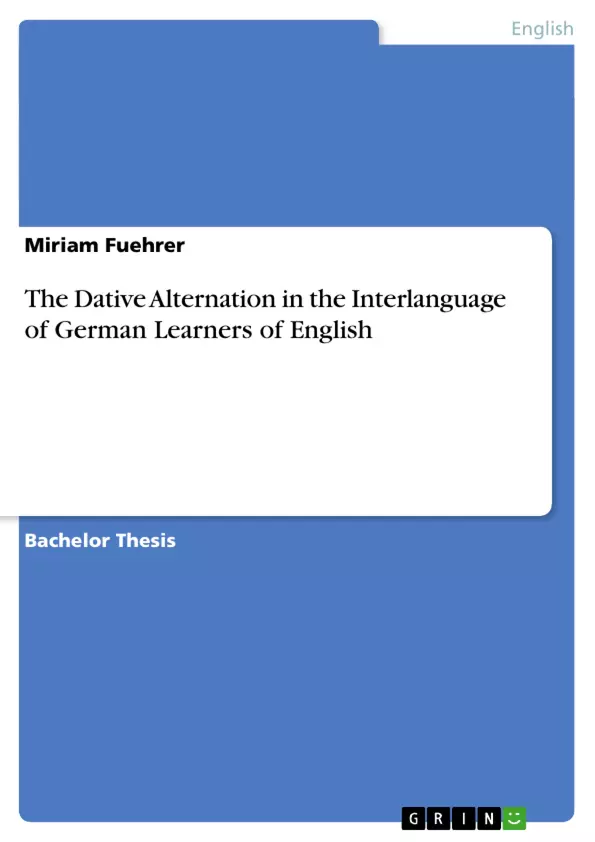Would you say you ‘...gave a good friend a scarf’ or would you rather say you ‘...gave a scarf to a good friend’? The grammatical phenomenon underlying the two syntactic variants – the double object dative [a good friend] [a scarf] and the prepositional object dative [a scarf] [to a good friend] – is the so-called 'dative alternation' (DA). The latter term captures this general ability in English to express the same event of giving with two distinct syntactic structures.
DA has been researched extensively for native speakers of English. Most of the scientific attention was directed at identifying the semantic and informational variables that give rise to the respective variants. Also, a number of corpus studies have revealed an interesting phenomenon commonly referred to as “lexical bias” (e.g. Wasow 2002). More precisely, researchers have found some dative verbs to occur more frequently in a prepositional dative variant (POD), whereas other dative verbs seem to favor the double object variant (DOD) (e.g. Davidse 1996; Stallings et al. 1998; Wasow 2002; Arnoldet al. 2003; Bresnan & Nikitina 2003). For example, Wasow (2002) found 'give' to occur in a DOD shape in 85% of his data, while Davidse (1996) found the verb 'throw' to occur in a POD shape in 90% of her data.
While DA has been widely explored for native speakers of English, relatively little is known about it in contexts of SLA. This study investigates how DA is reflected in the IL of German learners of English and, additionally, whether German learners exhibit similar lexical biases in their choice of dative syntax.
Raw data of early research on the acquisition of English DA by French native speakers (Mazurkevich 1984; Hawkins 1987) show similar lexical biases as observed for native speakers. This trend suggests that lexical biases are acquired by L2 learners of English. The latter is tested empirically in the present paper by means of a questionnaire study with 33 German-speaking learners of English. 16 American undergraduate students of the University of Montana serve as a control group.
The data obtained from the experiment show a significant influence of verbal lexis on dative argument choice (p<0.001) for the L2 learners. Additionally, L2 informants’ dative choices adhere to the same hierarchy as those of the native speakers. The fact that lexical biases are indeed reflected in informants’ ILs suggests that they are acquired by learners together with the dative alternation.
Inhaltsverzeichnis (Table of Contents)
- Introduction
- Phenomenon of inquiry: the English dative alternation
- Basic terms and terminology
- State of research
- Semantic approaches to the dative alternation
- Informational approaches to the dative alternation
- Predicting the dative alternation
- Lexical biases
- The present study
- Method
- Material design
- Test sets
- Participants
- American participants (group L1)
- German participants (group L2)
- Procedure
- Score
- Material design
- Results
- Discussion
- Conclusion
Zielsetzung und Themenschwerpunkte (Objectives and Key Themes)
This study examines the English dative alternation in the interlanguage of German learners of English, specifically investigating how they utilize the double object dative and prepositional object dative structures. The main objective is to determine whether German learners exhibit similar lexical biases in their choice of dative syntax as native speakers of English.- The English dative alternation and its syntactic structures
- The influence of semantic and informational factors on dative alternation processes
- The phenomenon of lexical bias in dative alternation
- Language transfer issues in the acquisition of the English dative alternation by German learners
- Empirical investigation of lexical biases in the interlanguage of German learners of English
Zusammenfassung der Kapitel (Chapter Summaries)
The introduction presents the core concept of the English dative alternation, highlighting the two main syntactic variants: double object dative and prepositional object dative. It briefly outlines the existing research on this phenomenon, focusing on both semantic and informational approaches to explaining its mechanisms.
The chapter on the present study details the research aims, particularly the focus on investigating the dative alternation in the interlanguage of German learners of English. It explores the potential influence of language transfer from German, which lacks a dative alternation, and examines the presence of lexical biases in the learners' production.
The chapter on methodology elaborates on the design and execution of the experiment, including the construction of test sets, participant selection, and the procedure used to collect data. The scoring method employed in the study is also described.
The chapter on results presents the findings of the experiment, analyzing the data collected from both American and German participants. The chapter on discussion interprets these results, exploring their theoretical implications and potential explanations for the observed patterns.
Schlüsselwörter (Keywords)
This study focuses on the English dative alternation, exploring its syntactic structures, semantic and informational influences, and the presence of lexical biases. Key concepts include language transfer, interlanguage, second language acquisition, and empirical research in the field of linguistics.- Citation du texte
- Miriam Fuehrer (Auteur), 2009, The Dative Alternation in the Interlanguage of German Learners of English, Munich, GRIN Verlag, https://www.grin.com/document/128427



